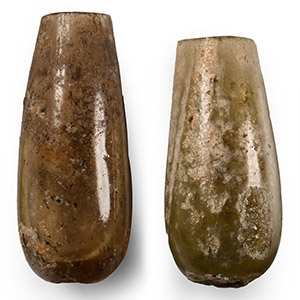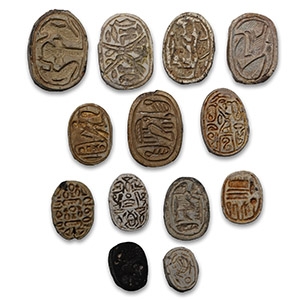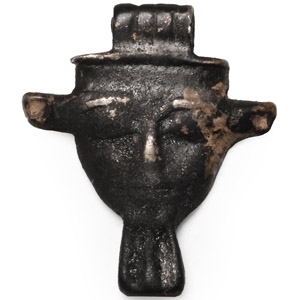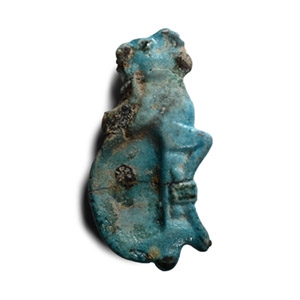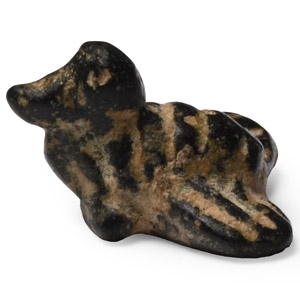Home > Auctions > 26 November - 1 December 2024
Ancient Art, Antiquities, Natural History & Coins
with Hotel des Ventes, Drouot, Paris, France.
From the collection of Mr H. Naudy, Paris, France.
Acquired at between 2004-2010.
Property of a French collector.
Cf. Andrews, C., Amulets of Ancient Egypt, London, 1994, p. 85, pl.87a, for a similar haematite example.
The stonemason’s plumb bob amulet was most frequently made of a dark hardstone like this example and paired with a set-square amulet. Plummet amulets were thought to grant their owner everlasting balance and harmony.
Ex John Moor galley, 1990s.
From the H.W. collection, UK.
Accompanied by a previous cataloguing card.
Mariaud de Serres, Paris, 1990s.
Cf. Bienkowski, P., Tooley, A., Gifts of The Nile: Ancient Egyptian Arts and Crafts in Liverpool Museum, Liverpool, 1995, p.68 and pl.103, for an example still attached to a mummy.
Acquired on the German art market, 1989-1995.
with The Museum Gallery, 19 Bury Place, London, WC1, UK, 1998-2003.
Property of a London based academic, 2003-present.
Cf. Friedman, F.D., Borromeo, G., Leveque, M. (eds.), Gifts of the Nile: Ancient Egyptian Faience, London, 1998, p.151 and p.239, for a similar dish in the Musée du Louvre, Paris (inv. no. E14188).
Faience food and dish simulacra replaced the wooden food preparation models of the earlier Middle Kingdom.
From an early 20th century collection.
Ex Mythes & Legend.
Ex Cohen collection 2011.
Property of a French collector.
Cf. Andrews, C., Amulets of Ancient Egypt, London, 1994, item 18(a).
In ancient Egyptian mythology, Isis was the sister-wife of Osiris and the mother of the sky god Horus. She is associated with aspects of fertility and motherhood and is often depicted in various artworks seated in a nursing pose with her son Horus on her lap, as here.
From the collection of Mr S.M., London, UK, formed from 1979-1999.
From an early 20th century collection.
The cat was sacred to Bastet, a protective mother goddess and the daughter of the sun god Re. Amulets provided the wearer with the goddess's protection.
Acquired in the mid 1980s-1990s.
Private collection, Switzerland, thence by descent.
Private collection, since the late 1990s.
Cf. Ben-Tor, D., Scarabs, Chronology, and Interconnections: Egypt and Palestine in the Second Intermediate Period, Zurich, 2007, pl.106, no.13, for a scarab with a similar arrangement for scarab 1; Ben-Tor, D., Scarabs, Chronology, and Interconnections: Egypt and Palestine in the Second Intermediate Period, Zurich, 2007, pl.50, no.1, for a scarab with similar longitudinally arranged design to scarab 2; Ben-Tor, D., Scarabs, Chronology, and Interconnections: Egypt and Palestine in the Second Intermediate Period, Zurich, 2007, pl.99, no.19, for a close parallel to scarab 3; Ben-Tor, D., Scarabs, Chronology, and Interconnections: Egypt and Palestine in the Second Intermediate Period, Zurich, 2007, pl.98, no.10, for a similar design to scarab 4; Ben-Tor, D., Scarabs, Chronology, and Interconnections: Egypt and Palestine in the Second Intermediate Period, Zurich, 2007, pl.85, nos.13 and 27, for scarabs with vertical arrangements of a falcon before a cartouche; Ben-Tor, D., Scarabs, Chronology, and Interconnections: Egypt and Palestine in the Second Intermediate Period, Zurich, 2007, pl.71, no.4, for a scarab with a similar motif to scarab 7; Ben-Tor, D., Scarabs, Chronology, and Interconnections: Egypt and Palestine in the Second Intermediate Period, Zurich, 2007, pl.84, no.14, for a similar scarab border to scarab 8; Keel, O., Corpus der Stempelsiegel-Amulette ausPalästina/Israel: Von den Anfängen bis zurPerserzeit: Katalog Band III: Von Tell el-Farʿa Nord bis Tell el-Fir, Zurich, 2010, p.23, no.47, for a similar format of design to scarab 9; Keel, O., Corpus der Stempelsiegel-Amulette ausPalästina/Israel: Von den Anfängen bis zurPerserzeit: Katalog Band IV: Von Tel Gamma bis ChirbetHusche, Zurich, 2013, p.81, nos.183-185, for seal impressions produced by similar scarabs to scarab 10; Keel, O., Corpus der Stempelsiegel-Amulette ausPalästina/Israel: Von den Anfängen bis zurPerserzeit: Katalog Band IV: Von Tel Gamma bis ChirbetHusche, Zurich, 2013, p.349, no.418, for a seal with a similar motto to scarab 11; Keel, O., Corpus der Stempelsiegel-Amulette ausPalästina/Israel: Von den Anfängen bis zurPerserzeit: Katalog Band II: Von Bahan bis Tel Eton, Zurich, 2010, p.109, no.28, for a similar design to scarab 12; Ben-Tor, D., Scarabs, Chronology, and Interconnections: Egypt and Palestine in the Second Intermediate Period, Zurich, 2007, pl.51, no. 61, for a scarab with a similar design to scarab 13.
The popularity of the scarab was so great that many of these scarab designs can be found outside Egypt at sites in the ancient Levant.
From an early 20th century collection.
From the private collection of the late Mrs Belinda Ellison, a long time member of the Egyptian Exploration Society, c.1940-2020.
Cf. The Drambuie Collection, Edinburgh (1850), for a comparable example from a foundation deposit; Vandier d’Abbadie, J., Les objets de toilette égyptiens au Musée du Louvre, Paris, 1972, p.31 nos. 69, 71-72, for examples of similar trussed ibex form cosmetic dishes.
Figurines of trussed ibexes in faience were occasionally included in foundation deposits, possibly to represent animals that were sacrificed. However, the shallow depression in the body of this animal is similar to the style of cosmetic dishes, indicating that this particular example may be a funerary object symbolising a more valuable toiletry item.
From a London, UK, based collection, 1990s.
337 - 348 of 3419 LOTS

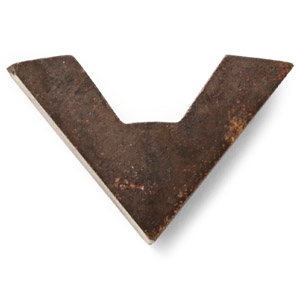
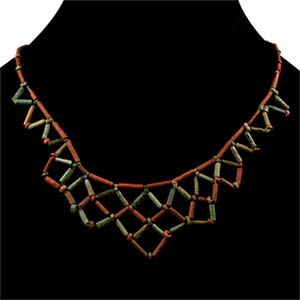
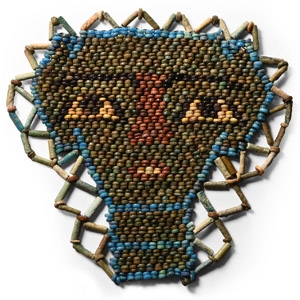
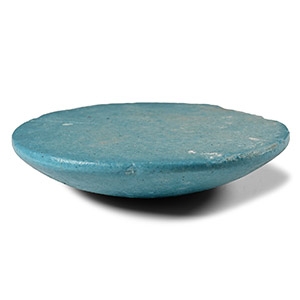
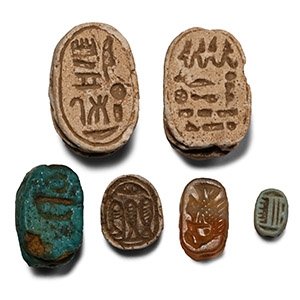
.jpg)
